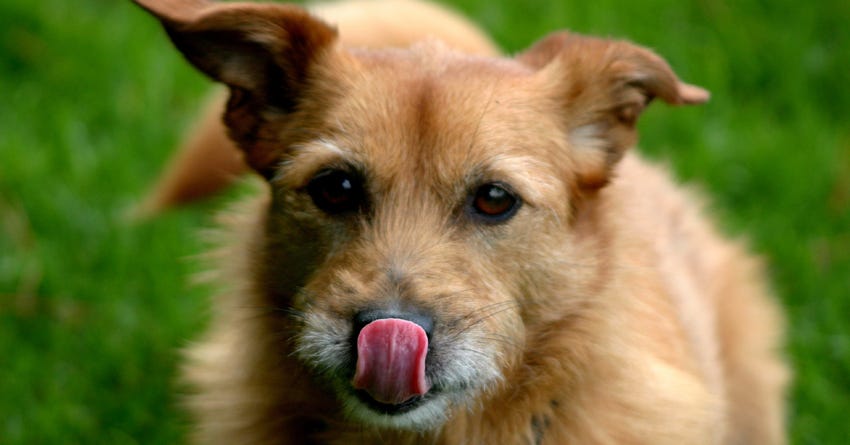There are many respiratory sounds that can be made by your canine or feline companion. Some sounds are more concerning and merit an immediate examination by a veterinarian. Other audible respiratory patterns should cause an owner to take notice, but don't necessarily need to be evaluated at three in the morning at an emergency veterinary hospital.
One of the most common respiratory patterns exhibited by dogs and cats that often causes some degree of alarm to unexperienced owners is reverse sneezing. Inspiratory paroxysmal respiration, mechanosensitive aspiration reflex, and pharyngeal gag reflex are scientific terms for reverse sneezing.
How can an owner tell the difference between reverse sneezing, regular sneezing, coughing, and choking?
With some awareness, experience, and common sense you’ll soon be able discern among these audible respiratory sounds your pet may make.
Coughing
Coughing is a forceful exhalation through the mouth typically paired with abdominal contraction to expel material from throat, trachea (windpipe), or lungs. Coughing can be productive (expelling mucus, liquid, or other substance) or non-productive (dry).
Choking
Choking is a reflex-like expulsion through the mouth of material that inadvertently gets stuck in the throat or enters the trachea. Generally, the term choking can be used interchangeably with gagging.
Sneezing
Sneezing involves vigorous evacuation of microscopic or visible materials from the nose or nostrils. Environmental allergens (pollen, mold, etc.) and irritants (dust, smoke, incense, etc.) cause inflammation in the nasal passages and lead to sneezing. Dry sneezing simply involves air being forcefully expelled. Wet sneezing may yield clear liquid, mucus, blood, or other fluids. Additionally, foreign material like a plant awn (foxtail, etc.) or a blade of grass can be cleared during sneezing.
Reverse Sneezing
Reverse sneezing is a rapidly repeating pattern of inhalation and exhalation in attempt to remove allergens and irritants from the nasal passages. The mouth is typically partially or fully closed to permit the primary movement of air to occur through the nose. During reverse sneezing, your pet may exhibit postural changes, including, standing still, extending the head and neck, angulation of the elbows away from the body (elbow abduction), sudden movement of the head in a reverse motion, and abdominal contractions.
Why do dogs reverse sneeze?
Like sneezing, a dog will reverse sneeze when an irritating substance enters his nasal passages. Environmental allergens, cigarette smoke, perfume/cologne, air freshener, incense, carpet deodorizers, cleaning products and others are all potential contributors to reverse sneezing and other respiratory problems. Infections with bacteria, viruses, or parasites (nasal mites, etc.) can also contribute to reverse sneezing. Pets having periodontal disease have more inflammation in the nasal passages from gingivitis and abnormalities in the tooth roots in the upper row of teeth (maxillary arcade) that communicate with the sinuses. The inflammation associated with periodontal disease permits oral cavity bacteria to enter the sinuses and can lead to sneezing, reverse sneezing, and other breathing abnormalities.
Do I need to be concerned about my dog’s reverse sneezing?
You may need to be concerned about your dog’s reverse sneezing if the episodes aren't stopping or are becoming more frequent or severe. Typically, reverse sneezing resolves itself over a period of seconds (0-60) when the irritating substance is expelled from the nose. With worsening episodes of reverse sneezing, have your pooch evaluated by a veterinarian on an emergency or appointment basis. In working up reverse sneezing, your veterinarian may need to perform a sedated or anesthetized examination, rhinoscopy (fiberoptic imaging), radiographs (X-rays), blood, testing, and more.
What can I do to help my pet during bouts of reverse sneezing?
It’s important to recognize that episodes of reverse sneezing are not episodes of seizure activity. Your dog isn’t going to bite off his tongue while reverse sneezing, so don’t put your hand inside his mouth in attempt to move the tongue out of the way of his teeth (as you’ll likely get bit).
Although there’s no specific treatment for reverse sneezing, many owners attempt to console their pet by gently stroking the throat or the back from the head to the tail. As there’s a need for rapid expansion and contraction of the chest cavity, don’t hold our pet tightly; doing so can prevent your pet from the big inhales and exhales needed to expel allergens. Gently tapping your pet on the nose or briefly covering the nostrils with your fingertips can promote swallowing and stop the spasming associated with reverse sneezing. Antihistamines (diphenhydramine hydrochloride, other) can reduce histamine release associated with allergic responses and should be used as per your veterinarian’s recommendation.
Can I prevent my pet from having reverse sneezing?
As you can’t keep your pet in an allergen-free plastic bubble all her life, there’s no 100% certain means of preventing reverse sneezing. My recommendations include:- Avoid using cleaning products that leave aromas around the house.
- Keep windows closed in the home, use air conditioning, and clean/replace air filters as per manufacturer guidelines.
- Don’t smoke or use candles, air fresheners, or anything that produces particulate matter that could be inspired inside your house.
- Commit to preventing or resolving your pet’s periodontal disease. Partner with your veterinarian to determine the most appropriate dental care plan for your pet (daily brushing, anesthetized dental, etc.).
- Walk your dog on a short, flat lead to prevent her from putting her nose in locations where environmental allergens can be inhaled.

